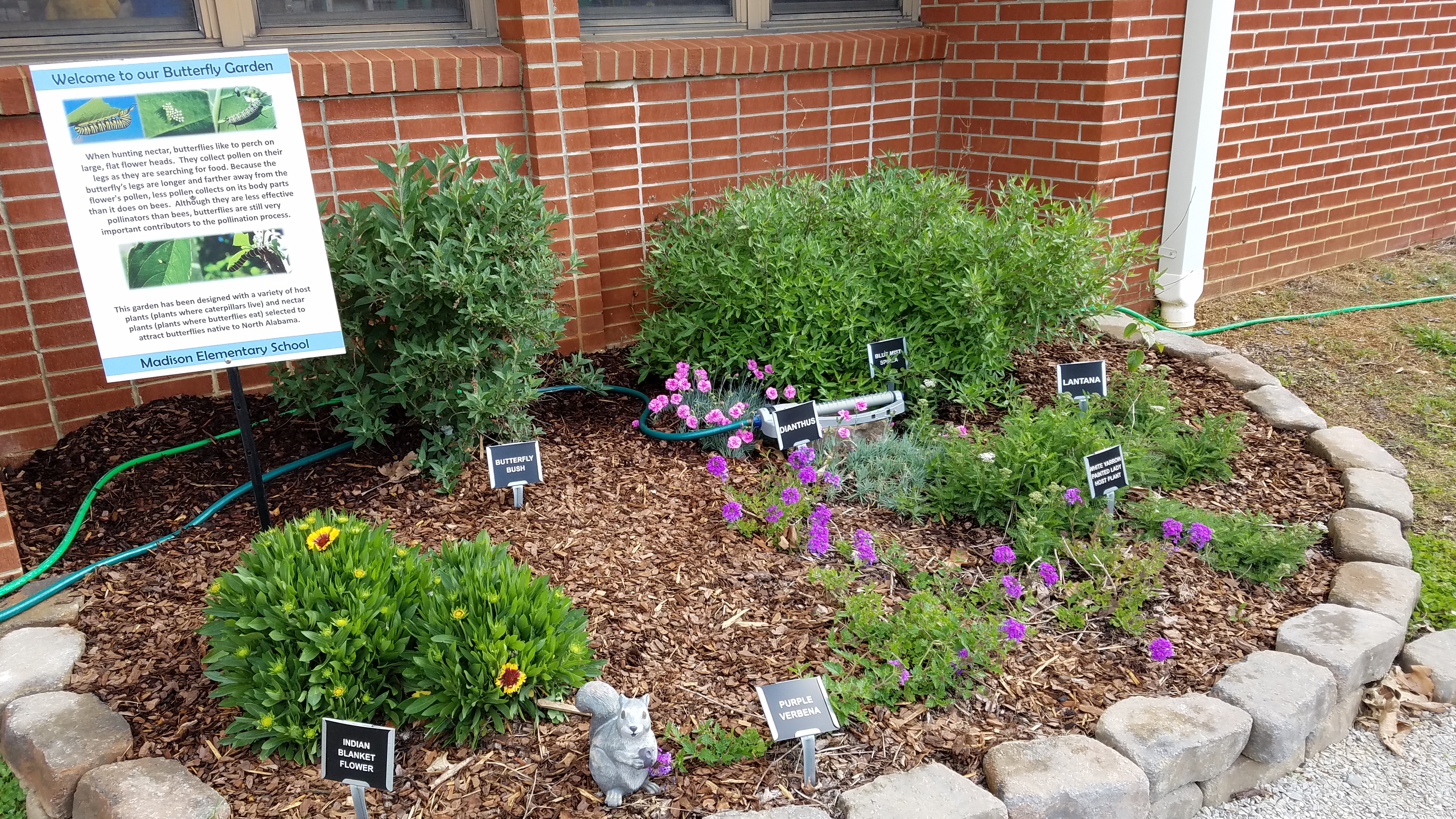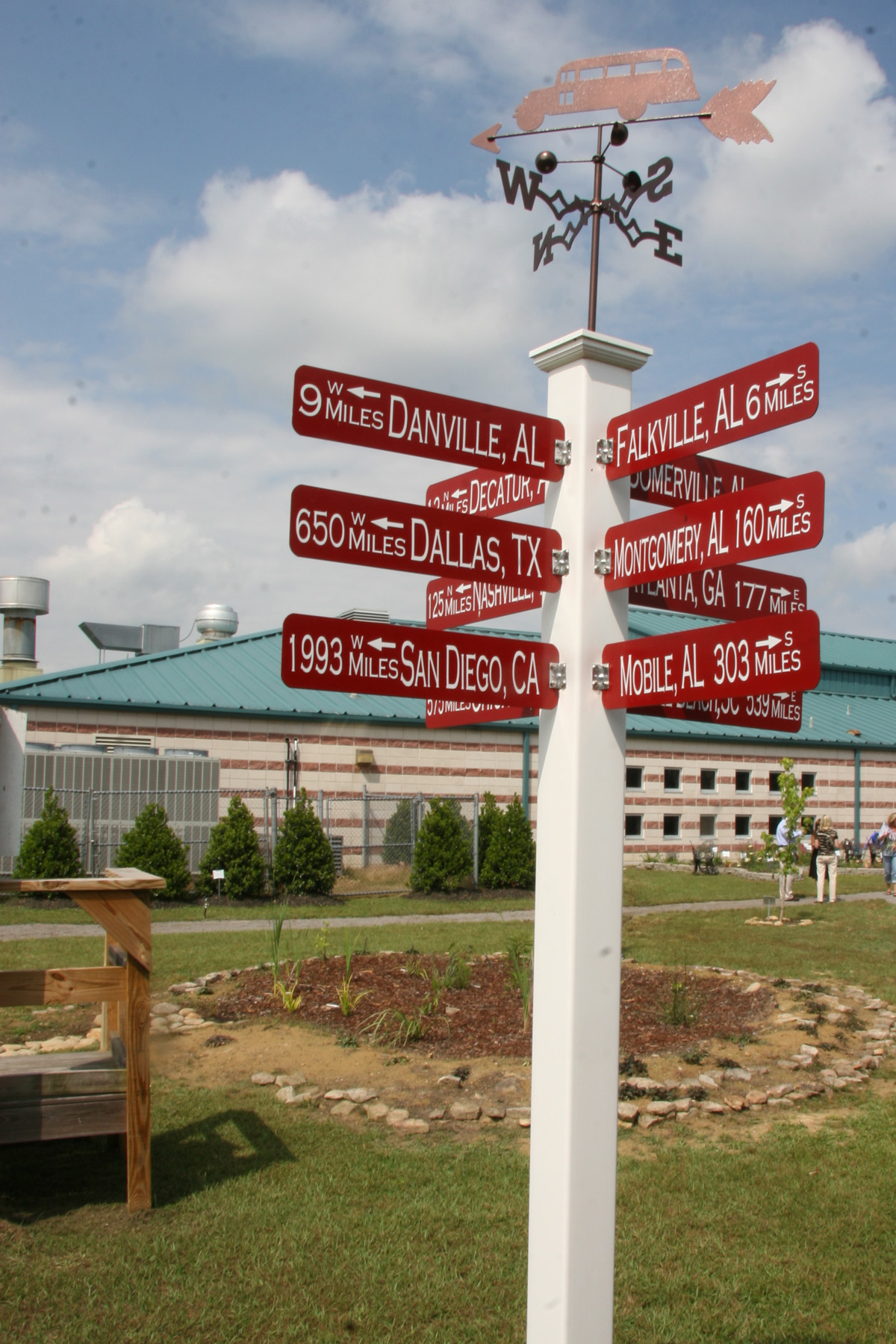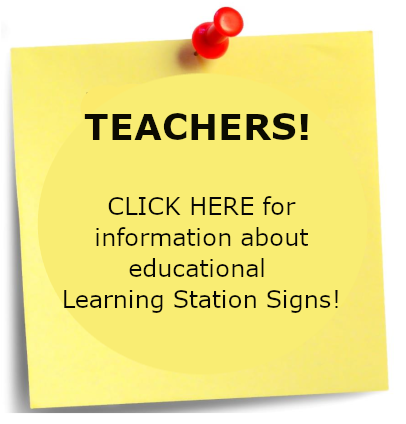Outdoor Learning Stations & Signs
An Outdoor Learning Station is an area developed around a specific topic (like weather) or a specific habitat (like a butterfly garden). Outdoor classrooms developed through the Alabama Outdoor Classroom Program include a wide variety of learning stations that help teachers utilize the outdoors as an educational tool for hands-on, inquiry-based activities.
Click on the links to the example learning stations and educational signage below for information to help you build, use and maintain the learning stations:
Core Learning Stations | Other Gardens | Other Learning Stations | Educational Signage | Student Exploration Links | Pavilions | Kiosks | Invasive Plants to Avoid
Required Core Learning Stations
These outdoor learning stations are required for certification through the Alabama Outdoor Classroom Program because these are the stations a school needs to teach Alabama's Life Science Standards from Kindergarten through high school Biology.

Butterfly Garden - includes flowering perennials for butterflies and "host" plants for caterpillars, so that students can observe the full life cycle of a butterfly, track butterfly migrations, and learn about the impact that habitat loss can have on the populations of butterflies and other animals.
Cardinal Directions Sign - is a 4-6 foot post with wooden arrows attached pointing to north, east, south and west (and can include wooden arrows with # of miles to important places such as Washington D.C., Montgomery, Gulf of Mexico, Atlantic Ocean, Pacific Oceans, etc.), so that students can track the path of the sun and clouds through the sky, monitor the shadows cast by the moving sun, and understand local geography.
Frog & Toad Habitat - includes a small pond and bog that provides food, water, and shelter for frogs and their tadpoles, so that students can observe the full life cycle of frogs, study the differences between the bog’s sandy soil and the more common red clay, and learn how a bog acts like a wetland as it absorbs and cleans rainwater.
Log Decomposition Station - includes logs and leaves placed on the bare ground, so that students can observe how decomposers like pill bugs (or rollie pollies) play a vital role in ecosystems as they break down the logs, leaves and other dead matter which then provides nitrogen, carbon, and energy for plants and other animals in the ecosystem.
Pollinator Garden - includes flowering perennials that provide nectar for bees, butterflies and other pollinators, so that students can observe pollination, learn how pollination is required to produce fruits and vegetables, and understand how the decline in bee populations can impact our food production.
Sensory Garden - includes perennials that engage all five senses such as lamb's ear, mint, and rosemary, so that students can learn how to use all of their senses as they record their observations and data in the outdoor classroom.
Songbird Sanctuary - provides food, water, shelter and places to raise their young for local songbirds, so that students can observe the different adaptations that bird species have that help them survive, use their geography skills as they track bird migration across the U.S., learn how humans can help create habitat for songbirds, and understand the role birds have in local ecosystems.
Weather Station - includes weather measurement tools (such as a thermometer for temperature, anemometer for wind speed and direction, barometer for air pressure, hygrometer for humidity, and rain gauge for rain fall) that students can use to measure, record and track weather conditions over time.
Other Gardens

Fall Vegetable Garden - a raised bed garden with annual vegetables planted to teach students about different types of plants, the importance of pollination, and healthy eating habits.
Hydroponics Garden - a form of gardening that uses no soil, but instead grows plants in a solution of water and nutrients.
Native Woodland Wildflower Garden - a shaded garden with moist soil where native woodland wildflowers bloom in the spring.
Pitcher Plant Bog Garden - a type of wetland constructed with peat moss and sand as soil where you can grow bog plants like the carnivorous pitcher plant.
Rain Garden - this semi-aquatic garden includes a chamber of pea gravel under the soil to collect rainwater from downspouts to help prevent erosion.
Theme Gardens - a raised bed garden that includes annual plants chosen around a specific topic such as an American Flag Garden, Color Wheel Garden, George Washington Carver Garden, Great Depression Garden, Native American/Three Sisters Garden, Row Crops Garden, or Veteran's Day garden.
Other Outdoor Learning Stations
Blueberry Bush Patch - an area where students can grow and harvest blueberries
Bluebird Box Trail - a trail of six to eight bluebird nesting boxes that are placed approximately 50-100 feet apart around the school's campus to provide highly needed habitat for these cavity nesting birds.
Box Turtle Habitat - An enclosed area that includes food, shelter, places to raise young, and water sources for two Eastern box turtles.
Compost Area - an area where you can collect "green waste" such as leaves, egg shells and coffee grounds, allowing the materials to break down into compost with time
Fruit Orchard - an area with fruit-bearing trees where students can harvest the fruit such as figs or apples
Student Sundial - (MORE INFO TO COME)
Measurement Walls - a wall where students compare their height to flowers (in standard measurements - feet & inches - AND in metric measurements - meters & centimeters) ...and/or... they compare their arm spans to the wingspans of common Alabama birds.
Tree ID Trail - ten to twenty native trees located around the school's campus with tree identification signs placed on or near them
Wildlife Tracking Station - an area on the ground that has muddy, sandy soil where footprints of visiting wildlife can be investigated
Worm Bin Farm/Vermiculture - A container where you raise red wiggler earthworms and use the worms for composting
Kiosks
Informational Kiosks - can be updated with information related to the outdoor classroom and its learning stations
.
Click on the links to the example learning stations and educational signage below for information to help you build, use and maintain the learning stations:
Core Learning Stations | Other Gardens | Other Learning Stations | Educational Signage | Student Exploration Links | Pavilions | Kiosks | Invasive Plants to Avoid
Required Core Learning Stations
These outdoor learning stations are required for certification through the Alabama Outdoor Classroom Program because these are the stations a school needs to teach Alabama's Life Science Standards from Kindergarten through high school Biology.

Butterfly Garden - includes flowering perennials for butterflies and "host" plants for caterpillars, so that students can observe the full life cycle of a butterfly, track butterfly migrations, and learn about the impact that habitat loss can have on the populations of butterflies and other animals.
Cardinal Directions Sign - is a 4-6 foot post with wooden arrows attached pointing to north, east, south and west (and can include wooden arrows with # of miles to important places such as Washington D.C., Montgomery, Gulf of Mexico, Atlantic Ocean, Pacific Oceans, etc.), so that students can track the path of the sun and clouds through the sky, monitor the shadows cast by the moving sun, and understand local geography.
Frog & Toad Habitat - includes a small pond and bog that provides food, water, and shelter for frogs and their tadpoles, so that students can observe the full life cycle of frogs, study the differences between the bog’s sandy soil and the more common red clay, and learn how a bog acts like a wetland as it absorbs and cleans rainwater.
Log Decomposition Station - includes logs and leaves placed on the bare ground, so that students can observe how decomposers like pill bugs (or rollie pollies) play a vital role in ecosystems as they break down the logs, leaves and other dead matter which then provides nitrogen, carbon, and energy for plants and other animals in the ecosystem.

Pollinator Garden - includes flowering perennials that provide nectar for bees, butterflies and other pollinators, so that students can observe pollination, learn how pollination is required to produce fruits and vegetables, and understand how the decline in bee populations can impact our food production.
Sensory Garden - includes perennials that engage all five senses such as lamb's ear, mint, and rosemary, so that students can learn how to use all of their senses as they record their observations and data in the outdoor classroom.
Songbird Sanctuary - provides food, water, shelter and places to raise their young for local songbirds, so that students can observe the different adaptations that bird species have that help them survive, use their geography skills as they track bird migration across the U.S., learn how humans can help create habitat for songbirds, and understand the role birds have in local ecosystems.
Weather Station - includes weather measurement tools (such as a thermometer for temperature, anemometer for wind speed and direction, barometer for air pressure, hygrometer for humidity, and rain gauge for rain fall) that students can use to measure, record and track weather conditions over time.
Other Gardens

Fall Vegetable Garden - a raised bed garden with annual vegetables planted to teach students about different types of plants, the importance of pollination, and healthy eating habits.
Hydroponics Garden - a form of gardening that uses no soil, but instead grows plants in a solution of water and nutrients.
Native Woodland Wildflower Garden - a shaded garden with moist soil where native woodland wildflowers bloom in the spring.
Pitcher Plant Bog Garden - a type of wetland constructed with peat moss and sand as soil where you can grow bog plants like the carnivorous pitcher plant.
Rain Garden - this semi-aquatic garden includes a chamber of pea gravel under the soil to collect rainwater from downspouts to help prevent erosion.
Theme Gardens - a raised bed garden that includes annual plants chosen around a specific topic such as an American Flag Garden, Color Wheel Garden, George Washington Carver Garden, Great Depression Garden, Native American/Three Sisters Garden, Row Crops Garden, or Veteran's Day garden.
Other Outdoor Learning Stations
Blueberry Bush Patch - an area where students can grow and harvest blueberries
Bluebird Box Trail - a trail of six to eight bluebird nesting boxes that are placed approximately 50-100 feet apart around the school's campus to provide highly needed habitat for these cavity nesting birds.
Box Turtle Habitat - An enclosed area that includes food, shelter, places to raise young, and water sources for two Eastern box turtles.
Compost Area - an area where you can collect "green waste" such as leaves, egg shells and coffee grounds, allowing the materials to break down into compost with time
Fruit Orchard - an area with fruit-bearing trees where students can harvest the fruit such as figs or apples
Student Sundial - (MORE INFO TO COME)
Measurement Walls - a wall where students compare their height to flowers (in standard measurements - feet & inches - AND in metric measurements - meters & centimeters) ...and/or... they compare their arm spans to the wingspans of common Alabama birds.
Tree ID Trail - ten to twenty native trees located around the school's campus with tree identification signs placed on or near them
Wildlife Tracking Station - an area on the ground that has muddy, sandy soil where footprints of visiting wildlife can be investigated
Worm Bin Farm/Vermiculture - A container where you raise red wiggler earthworms and use the worms for composting
Kiosks
Informational Kiosks - can be updated with information related to the outdoor classroom and its learning stations
 Wildlife Tag
Wildlife Tag
